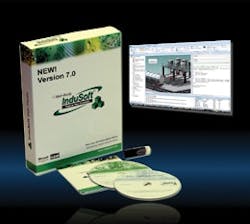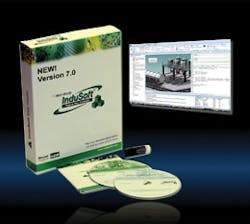Contemporary HMI Visualization
During the Windows NT, 2000 and XP era, most HMI/SCADA development software looked much like the Microsoft Office products of the period. Now that Windows 7 and Office 2007—and soon Office 2010—are integrated into the market, the industrial marketplace expects visualization capabilities to keep up.
In response to that expectation, InduSoft is updating its HMI/SCADA development environment to look like Office 2007 or Office 2010, with a Ribbon interface. Developers used to have to hunt through various menus and dropdowns just to find the tools they needed. The advent of the customizable toolbar helped, but now the Ribbon interface corresponds to how people work within the product. An easier, more intuitive interface means reduced development time and higher productivity.
Gadbois says Version 7.0 is fully compatible with Windows 7 and Windows Server 2008 R2 (32- and 64-bit), including the new "jump list" feature in Windows 7. "Applications developed with Web Studio also can be deployed on Windows CE and Windows Mobile, including Smartphone, Windows Vista, XP and XP Embedded and Windows Server 2003," she adds. "The same development environment creates applications that can be scaled to a wide range of devices. The number of products to learn and maintain is kept to a minimum to allow developers to finish projects and ship machines more quickly."
Along with OPC support and more than 200 built-in drivers previously included, Indusoft adds that Version 7.0 provides new or updated drivers for Eaton ELC, Siemens, Opto 22, CAN and BACnet.
Turning raw data into actionable information can improve efficiencies. Key performance indicators (KPIs) and overall equipment effectiveness (OEE) are metrics best collected and calculated automatically. Collected data can be stored either locally or remotely in an SQL database, and, if needed, redundancy can be implemented. Data trend presentation in Version 7.0 has been enhanced, states Gadbois. "Trends optionally can be area-filled below the pen line to make data easier to understand at a glance and almost effortless to see from a distance," she says. "The new trending support includes transparency, text annotations and superimposed graphics."
Version 7.0 has online, automatic, multilanguage translation. "A single click translates the entire project," says Gadbois. "Support for Unicode fonts, including Arabic, Chinese, Cyrillic and Japanese, helps to ensure applications can be understood and used in almost any country, since our customers always find new places to sell products and services. They can offer their screens in any local language, and make them easier to understand for those who don't speak English fluently."
Version 7.0 also introduces a revamped runtime security system that can share settings among multiple stations to improve system robustness or integrate with Microsoft Active Directory to reduce the burden of network administration.


